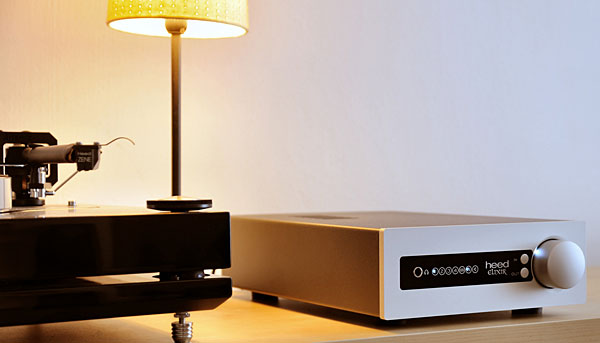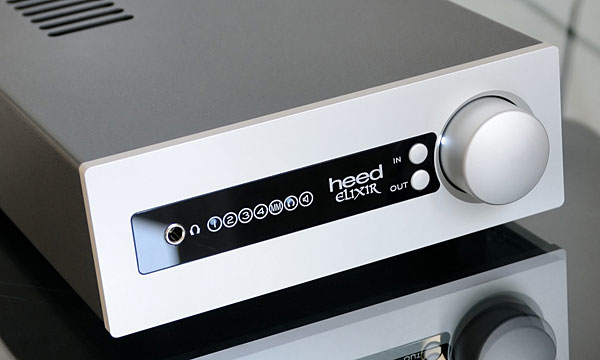| Columns Retired Columns & Blogs |
I'd love to see Head make an Amp with AV Passthrough ... some of use do not have the option to have two setup's.
Listening
Bob Clarke recommended that I leave the Heed powered up 24/7, I assume to keep the capacitors charged and ready to rock'n'roll. The Elixir ran hot, but never crazy-hot.
I listened to the Elixir in multiple system configurations, beginning with my nearfield-positioned smaller rig: Music Hall MMF-7.3 turntable with Ortofon 2M Bronze cartridge ($1595), and a choice between two pairs of stand-mounted speakers: Elac Debut B6 ($279/pair) and Snell J/Type II ($680/pair, ca 1989). For part of this review I spun my last vinyl purchases from the recently closed Other Music, a one-of-a-kind record store for music lovers that operated on Manhattan's W. Fourth Street from 1995 to 2016. R.I.P.!
Heed, say hello to Snell
I don't know if it was down to the Heed's capacitors directly interacting with my Snell J/Type IIs, but I was immediately struck by the Elixir's superb sense of flow. The Elixir portrayed dynamic swings with a natural and effortless musicality. I wasn't immediately drawn to unearthing individual facets of the Heed's sound so much as enjoying its ebb and flow, its tactile inhalations and exhalations of the music. The Elixir made more music with the Snells' 92dB sensitivity and 8 ohm impedance than any other amplifier I've used. The J/Type IIs can sometimes sound closed-in, hard, anal-retentive—but powered by the Heed, they spun a complete 180. Their bass was now full and ripe, their tonality saturated and rather glorious. Color me stunned. Not even the grand Shindo Haut-Brion makes the Snells sound this human, warm, and righteous.
As I played the shimmering hipster country of Laura Gibson's Empire Builder (LP, Barsuk BARK 162LP), the Heed-Snell combo created a juicy sense of audio buoyancy, the music floating before me on a cloud of steel guitars and pizzicato bass backing Gibson's odd, ethereal voice, her nerdy goodness and graceful tunes—like June Carter by way of Emmylou Harris.
Sam Beam and Jesca Hoop's exquisite Love Letter for Fire (LP, Sub Pop SP1165) is another scruffy-beard-and-calico-dress favorite, and the Heed-Snell combo again worked its magic: voices sounded clear and intimate, while the album's dense, fairyland production style was well resolved in a cotton-candy-friendly soundstage. The Heed's unerring warmth, consummate energy, and ability to resolve vast macrodynamic swings was a consistent surprise—nearly a revelation.

"Trane's Blues," from Workin' with the Miles Davis Quintet (LP, Prestige PRLP 7166), revealed another consistent Elixir trait: tonal color that leaned toward the darker side of neutral. This darkness could occasionally equal overcast, but was largely of the rich, warm variety—more an inclusive benefit than a torpor-inducing cloud. The Heed didn't resolve recordings to the point of revealing "air," as some describe it. Instead, the Heed designers seem to have opted for a balance: a harmonious blend of the Elixir's warmer and darker approach with powerful dynamics, touchable textures, and a set-it-and-get-it mandate that made the music the focus, not the gear.
And when I maxed the volume, which I often do, the music only sounded better! That force fully revealed itself with Colin Davis and the Boston Symphony Orchestra's recordings of Sibelius's Symphonies 5 and 7 (LP, Philips 6500 959). The Heed drew me into these moody recordings, the swirling layers of orchestral intensity working my emotional sectors like Nero fiddling as fires blazed. My listening notes ranged from "velvet" and "forceful" to "human-sounding" and "cozy." The Elixir brought me into the music, and left no room for resistance.
Heed, meet Elac
The Heed Elixir worked similar, if not as dramatic, magic with the Elac Debut B6 as with the Snell J/Type II, confirming and extending the Elac's strengths. Images of voices and instruments were extremely well focused, almost spooky in their graphic realism, if perhaps smaller overall. The Beam-Hoop LP sounded more close-up and more snug-fitting to my ears, with a tangible, leading-edge precision clearly spelled out on every image. "Trane's Blues" knocked me flat with extended cymbal decay, definition of Paul Chambers's gut-strung double bass, and increased richness and burnished glow from Miles's sizzling trumpet. Brilliant! I've heard this Miles Davis LP through umpteen-zillion-dollar rigs, but the Heed-Elac duo took a backseat to none. I could've stayed in the sweet spot for hours. But the headphones were calling . . .
Pay Heed! to Master & Dynamic
I kept Miles on the 'table and plugged in the Master & Dynamic MH40s ($399): lambskin-clad headphones respected for their natural, easy sound. I heard no great revelations; my inner ears didn't perk up to improved textures or sonic secrets unveiled. Side D of Radiohead's A Moon Shaped Pool (2 LPs, XL Recordings XLLP790) sounded buttoned-down and proper, its bumping surdo drum and finger-plucked guitars rolling forward, though not especially tactilely or engagingly. Perhaps the M&D's easygoing character, coupled to the Heed's dark sound, created a standoff. Music was well defined, and accurate in a neutral sense, but I made no musical discoveries beyond those already offered by the Snell and Elac speakers.
Heed Meets Music Hall, Ortofon, and DeVore Fidelity
I moved the Heed and my Music Hall MMF-7.3 turntable with Ortofon 2M Bronze cartridge into my big rig—my Kuzma turntable and tonearm were malfunctioning—and hooked them up to my DeVore Fidelity Orangutan O/93 speakers. Revelation City! All the rich color, flow, and slam of the smaller rig were present through the larger DeVores, and the sound was stupendous. The Elixir's solid-state innards were obvious in its lack of spatial depth and a wee bit of hard transient edge, but the music unfurled to communicate with and move me—the amplifier's otherwise elephant-sized soundstage was shocking.

The DeVores took to the Heed's solid-state-to-capacitor outputs like a T-bone lapping up Heinz 57. The Beam-Hoop album sounded as sweet as before, but better fleshed out, with deeper bass tones and a greater sense of organic life: that is, of actual musicians playing before me in space. Laura Gibson's Empire Builder sounded oddly synthetic and somehow hollow, while my reference Miles Davis Quintet album, Workin', profited greatly from the Heed's forceful staging and plush appeal, from Chambers's chomping low-bass notes to the in-your-face splat! of Davis's trumpet. Compared to my Shindo separates, the Heed re-created music with harder edges, less saturated tonal colors, and fewer filigreed details or graceful musical lines. But the Elixir's extended midbass to low-bass notes and the robust physicality of its sound made every record a stone gas.
Conclusions
Some reviews write themselves: Some audio products, created by designers who understand and implement the key elements required to make music sing, are tuned finely enough to be able to let the music speak. The Heed Elixir is such a product: a versatile integrated amplifier whose strengths include musical momentum, a touchable and delicious midrange, first-row re-creation of voices, and a very large soundstage. The Elixir produced good microdynamics, and its big'n'bouncy macrodynamics presented me with endless surprises from my favorite reference recordings. That so much amplifier is available for $1195 should have music lovers dancing, unclothed and unhinged, across fields and meadows, melodies on their lips, as creatures great and small join them in song. Incautiously, happily recommended.

I'd love to see Head make an Amp with AV Passthrough ... some of use do not have the option to have two setup's.